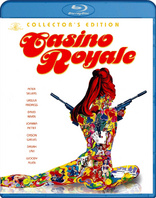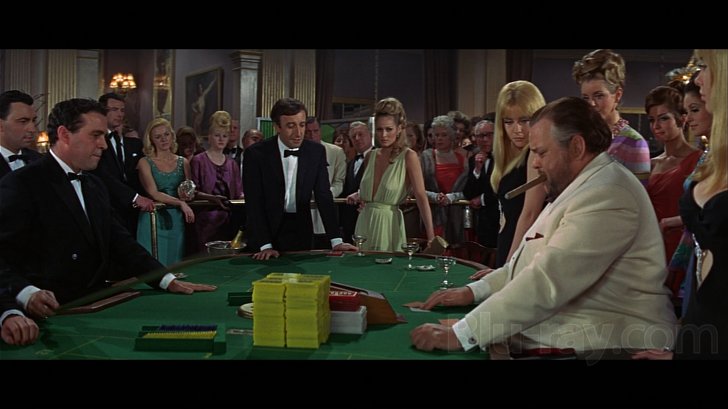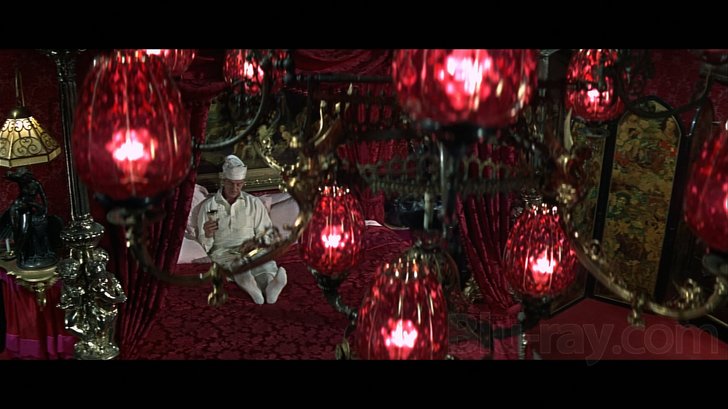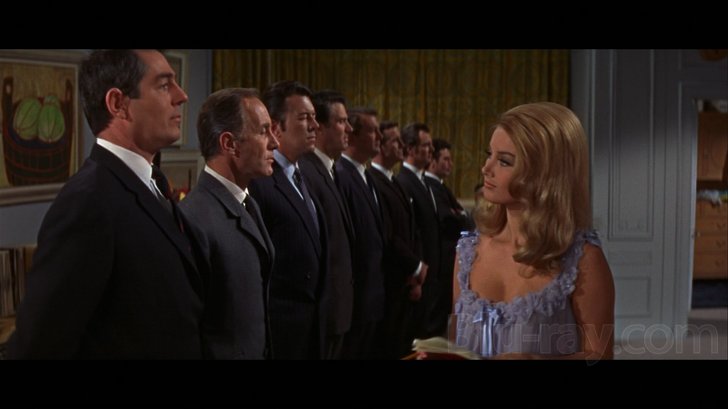Casino Royale Blu-ray Movie
HomeCasino Royale Blu-ray Movie 
Metro-Goldwyn-Mayer | 1967 | 131 min | Not rated | May 29, 2011
Movie rating
5.4 | / 10 |
Blu-ray rating
| Users | 3.5 | |
| Reviewer | 2.0 | |
| Overall | 3.1 |
Overview
Casino Royale (1967)
In a chaotic send-up of the Bond franchise, Sir James Bond is called back out of retirement to stop SMERSH. In order to trick SMERSH and Le Chiffre, Bond decides to name every agent "James Bond". One of the Bonds, whose real name is Evelyn Tremble, is sent to take on Le Chiffre in a game of baccarat, but all the Bonds get more than they can handle.
Starring: Peter Sellers, Ursula Andress, David Niven, Orson Welles, Joanna PettetDirector: John Huston, Ken Hughes, Val Guest, Robert Parrish, Joseph McGrath
| Adventure | Uncertain |
| Comedy | Uncertain |
| Action | Uncertain |
Specifications
Video
Video codec: MPEG-4 AVC
Video resolution: 1080p
Aspect ratio: 2.34:1
Original aspect ratio: 2.35:1
Audio
English: DTS-HD Master Audio 5.1 (48kHz, 24-bit)
Spanish: Dolby Digital 2.0 Mono
French: Dolby Digital 2.0 Mono
German: Dolby Digital 2.0 Mono
Italian: Dolby Digital 2.0 Mono
Spanish: Dolby Digital 2.0 Mono
Spanish=Latin & Castillian
Subtitles
English SDH, French, German, Italian, Japanese, Spanish, Danish, Dutch, Finnish, Norwegian, Swedish
Discs
50GB Blu-ray Disc
Single disc (1 BD)
Playback
Region free
Review
Rating summary
| Movie | 1.0 | |
| Video | 3.5 | |
| Audio | 4.0 | |
| Extras | 4.0 | |
| Overall | 2.0 |
Casino Royale Blu-ray Movie Review
We are not amused, Mr. Bond
Reviewed by Michael Reuben June 12, 2011Everyone should see the original Casino Royale. For one thing, Peter Sellers is in it,
and even bad Sellers is entertaining. Then there's the parade of guest stars and cameos, including
a few by people who weren't yet famous but eventually would be, including a baby-faced
Jacqueline Bisset. There's the overwrought, insanely expensive (for the era) production design
and the "anything goes" spirit that would inspire scenes in later films by such admirers as the
Monty Python group and Mel Brooks.
Finally, there's the unique sensation that every film fan should experience at least once - that of
trying to follow a film that truly makes no sense. In the words of one of this disc's audio
commentators, Casino Royale is "a circus gone mad", and not in the controlled fashion that a
genius like Fellini might manage to pull off. The narrative was so fractured that, in the end, one
of the five directors was handed every version of the script (not including variations written on
the day) and told to find something resembling a story. Anyone who's ever indulged in hyperbole
about a contemporary piece of Hollywood junk needs to see Casino Royale, if only to recalibrate
their standards. It'll be a long time before anyone ever scores this high on the train wreck scale.
Casino Royale was originally conceived as a send-up of Bond films in the style of What's New
Pussycat, which had been a big success in 1965 for its producer, Charles Feldman, and also
featured Peter Sellers, Woody Allen and Ursula Andress. Traces of the original conception can
be spotted among the wreckage, and the film is best appreciated as a series of disconnected set
pieces, some of them mildly entertaining. The description below makes no effort to avoid plot
spoilers, because there isn't a plot to spoil.

The film opens with a man (Sellers) identified as "James Bond" meeting with a contact named Mathis (Duncan Macrae) in a French pissoir. The film will be more than half over before we return to this pair, by which time we'll have learned that the man is not, in fact, James Bond but Evelyn Tremble, who is not actually a British agent but the creator of a crack system for winning at baccarat. But that's not important now.
After an elaborate title sequence that could be deemed either a homage to Bond films or an effort to hoodwink the audience into believing they're about to see one (as with so many things in Casino Royale, it's all a matter of perspective), we meet the real Sir James Bond (David Niven). Anyone who knows Ian Fleming's world should immediately recognize that we've left it, since Fleming's Bond promptly declined a knighthood when it was offered to him at the conclusion of The Man with the Golden Gun. But in the world of Casino Royale, Sir James accepted and retired from spying, allowing the Secret Service to assign his name and number to another agent, whose public and lascivious exploits are a constant source of embarrassment. Sir James lives a cloistered life of ascetic contemplation on an estate surrounded by lions. Why lions? No obvious reason, other than the fact that it allows the soundtrack to quote Bond composer John Barry's score for Born Free, one of many geeky inside references strewn throughout the film.
Sir James receives a visit from M (John Huston) accompanied by top representatives of the spy agencies from the Soviet Union, France and the United States (Kurt Kasznar, Charles Boyer and William Holden). Someone is killing their agents, and the four powers have put aside their differences in the face of a common threat. Will Sir James assist them? When Bond declines, M signals his forces to destroy Bond's compound. Unfortunately for M, he also dies in the attack, along with all of his counterparts (except for William Holden's CIA man, who inexplicably reappears in the film's finale).
Sir James travels to Scotland for M's funeral ceremonies, which are held at the ancestral home of the McTarry clan. Unbeknowst to Bond, the residence has been infiltrated by the mysterious organization attacking the world's spy agencies, and it's claimed the loyalty of M's widow, Lady Fiona McTarry (Deborah Kerr), along with all her servants and nubile adopted daughters. Their orders are to corrupt Bond and, failing that, kill him. (Fans of Monty Python and the Holy Grail will spot the precursor of Sir Galahad and the Castle Anthrax.) Lengthy scenes of seduction, carousing, combat and grouse-hunting ensue; the last proved especially difficult to film, because the director of this section, John Huston, insisted on filming in Ireland, where he had a home - and Ireland has no grouse. Sir James eventually triumphs, and Lady Fiona enters a convent. Seriously.
Bond goes to London to take control of M.I.5. There he finds Moneypenny (Barbara Bouchet) unchanged by the years, because she is, in fact, the daughter of the original Moneypenny. Sir James's first move as M's successor is to rename every remaining agent as "James Bond", because somehow this will serve to confuse the enemy (not to mention the audience). The only agent whose name won't have to be changed is Sir James's nephew, Jimmy Bond (Woody Allen), who is, at the moment, missing. Sir James then directs Moneypenny to develop a training program designed to enhance the resistance of male British agents to sexual temptation. The main purpose of the program seems to be to provide an excuse to parade as many comely female figures across the screen as possible. The most accomplished graduate of the program is Cooper (Terence Cooper), who, after much passionate necking and a few judo moves, disappears from the film until the last twenty minutes.
Moneypenney tells Sir James where to find Mata Bond (Joanna Pettet), his illegitimate daughter with Mata Hari. Bond recruits his daughter to visit the spy school in Berlin where her mother was trained, because it seems to have been the source for the clan that attacked him in Scotland. Mata steps into a taxi in London and exits the same taxi in West Berlin, where she promptly enters a German expressionist film, as such a film might have been made by Mack Sennett and the Marx Brothers. Among other things, the Berlin school is the scene of an auction where an international espionage figure known as Le Chiffre (Orson Welles) is planning to auction off his collection of blackmail material to the highest bidder among the Americans, British, Soviets and Chinese. What does Le Chiffre have to do with the plot that Sir James was called out of retirement to investigate? Why, nothing. How pointless of you to ask.
Mata Bond sabotages the auction and narrowly escapes, leaving Le Chiffre with no choice other than gambling to raise the money he needs to repay the Soviet agency SMERSH. Why does Le Chiffre owe SMERSH? Again with the pointless questions!
Meanwhile, in London Sir James contacts Vesper Lynd (Ursula Andress), a shady woman whose business is never specified but has made her wealthy enough to buy Nelson's statue from Trafalgar Square. Vesper recruits Evelyn Tremble (Peter Sellers), and finally we begin circling back to the film's opening - but not before a long interlude of Vesper seducing Evelyn and getting him to dress up in alternate identities, including Napleon, Hitler and Toulouse-Lautrec. The film's single most durable element occurs during this sequence: the Burt Bacharach/Hal David song "The Look of Love".
Vesper wants Tremble to use his baccarat system to beat Le Chiffre at Casino Royale. Tremble is given a crash course in spy skills, allowing the film to parody the standard "Q Division" sequence. Tremble is then christened "James Bond" in accordance with Sir James's new directive, and sent into the field. After many elaborate scenes in and around the casino, including scenes of Le Chiffre performing magic tricks at the baccarat tables, Tremble/Bond cleans out the mysterious man, collects his winnings and leaves with Vesper. But when Vesper is kidnapped by Le Chiffre's men just outside Casino Royale, Tremble/Bond gives chase. In one of the film's many unexplained leaps, the film cuts directly from Tremble/Bond driving off to his being held prisoner by Le Chiffre. The real explanation? By that point, Sellers had been fired from the picture, and this was all the footage they had.

In both Fleming's novel and the Daniel Craig film, Le Chiffre lashes Bond in the testicles to force him to give up the money. But in this film, Le Chiffre tortures Bond with hallucinations induced by unspecified means. This allowed the film to deal with then-applicable standards for what could be shown in a motion picture, and it also allowed producer Feldman to claim that his film was "psychedelic". In any case, Bond resists long enough for SMERSH agents to bust in and kill Le Chiffre. End of caper, right?
Of course not. Le Chiffre and the card game were there solely to preserve a vague connection to the original novel and because, having shot a lot of expensive footage with Orson Welles and Peter Sellers, the producer was damn well going to use it. Connecting it to the rest of the film? Don't bother me with details.
Back in London, Sir James attends a meeting with the Prime Minister, accompanied by his daughter, Mata Bond. While she's waiting for him, she's kidnapped by some of the same crew that attacked Sir James in Scotland at the beginning of the film. They escape with her in . . . a spaceship! Yes, a spaceship that lands in the middle of London and takes off again, while crowds stare in amazement. (And you wondered where the Python crew got the idea for the spaceship in Life of Brian!)
A mysterious nun appears in Sir James's office and hands him a note; she turns out to be the former Fiona McTarry, and the note explains that Mata Bond has been taken to Casino Royale. Sir James and Moneypenny go there and, after many adventures through numerous "psychedelic" (and very expensive) sets, they finally confront the true evil mastermind of the film, the fiendish "Dr. Noah". But he turns out to be Jimmy Bond, Sir James's nephew, whose endgame is to release a virus into the atmosphere that will make all women beautiful and all men shorter than him. Woody Allen, who wrote his own material, is genuinely funny in these scenes, but they'd be better if they followed logically from the preceding two hours.
The film ends the best way that a film with no plot can: with a giant brawl at Casino Royale. (It's been suggested that the idea came from Terry Southern, who was one of the writers, and that it represented his "second chance" to do the pie fight with which he'd wanted to end Dr. Strangelove.) The British forces receive American assistance in the form of cowboys on horseback and Native Americans who parachute from above (and do some remarkable dance steps); there's also a bubble machine, an airborne dispenser of laughing gas, George Raft and a gendarme played by Jean-Paul Belmondo. Ultimately, the entire casino detonates in a giant explosion, courtesy of Jimmy Bond, who has accidentally swallowed a pill of his own creation containing tiny nuclear time pills.
So intense was Bond-mania in 1967, and so eager was the public for anything Bond, that Casino Royale was the third highest-grossing film of the year, behind You Only Live Twice and The Jungle Book. Despite massive cost overruns, the film made money for Columbia Pictures, its original studio. But unlike the "official" Bond films produced by Eon Productions, Casino Royale has not had a long and profitable life being issued and reissued on home video. The film doesn't hold up, and it has nothing to recommend it except the unique quality of experiencing what Ed Wood might have made if he'd had a talented cast and crew and a budget to match.
One thing does hold up, though, and that's the beautiful Burt Bacharach score, which deserved a better movie to accompany it. In addition to "The Look of Love", which has since been covered by various artists, themes from the soundtrack routinely turn up in compilations, either of Bacharach's work or of movie music, and first-time viewers may be surprised to hear a familiar melody on the soundtrack. In that sense, Bacharach is a little like Shakespeare; his idiom has so thoroughly penetrated our musical vocabulary that you're startled to hear the original, and you think, "So that's where it comes from!"
Casino Royale Blu-ray Movie, Video Quality 

The AVC-encoded transfer is smooth and film-like, with a grain structure that is visible but not
intrusive. Black levels are generally excellent, as they need to be in all scenes in the casino (with
all the gentlemen in their tuxedos) or the Berlin sequences, with its many dark interiors. The
breadth and variety of rich, saturated color is especially noteworthy in interior scenes, where
cinematographer Jack Hildyard (The Bridge on the
River Kwai) had the freedom to light with the
full intensity required for the slow film stocks and anamorphic lenses of the day. (The lights
generated so much heat that the rotund Orson Welles had to change his entire costume after each
take, because it was soaked with perspiration.) Colors in outdoor scenes, which rely more on
natural light, tend to be less intense, but outdoor scenes are the exception in this film, where
artifice prevails.
Detail is generally quite good, allowing one to take in the full extent of the elaborate production
design. However, the image is somewhat soft, which appears to be inherent in the original
photography, and is certainly to be expected in the many shots that used opticals to achieve
effects that today would be created by CGI. No artificial sharpening or noise reduction appears to
have been applied. The source materials are in excellent condition.
A further note: While preparing this review and creating screenshots, I have played back Casino
Royale on three different players: a Panasonic BDP-50, a PS3 and a BD-ROM drive on my
desktop using playback software. On the BD-ROM drive, I noticed significant vertical "banding"
in the latter third of the film, but this was nowhere to be seen on the Panasonic or the PS3. This
confirms, yet again, that the playback device can be a critical element in what one sees on a Blu-ray.
Casino Royale Blu-ray Movie, Audio Quality 

Casino Royale was originally released in both mono and 6-track 70mm. Bacharach's score was recorded in stereo and was long considered a reference recording. The Blu-ray's soundtrack is DTS-HD Master Audio 5.1, and it sounds terrific, within the limitations of the source. Except for occasional dialogue pans left and right, the mix is largely front-centered. Effects such as gunshots or explosions have relatively little impact, but that may be by design, since the film was intended as a spoof. Indeed, many of the effects seem to be aiming for a "smaller than life" style. Meanwhile, dialogue remains clear, and Bacharach's richly reproduced score seems to float above the silly proceedings onscreen like the independent marvel it is.
Casino Royale Blu-ray Movie, Special Features and Extras 

The features have been ported over from the 2008 "40th Anniversary" DVD. However, as with
that DVD edition, features contained on a previous 2002 DVD have been omitted. These include
a "Making Of" featurette hosted by Val Guest, one of the film's directors, and a portion of the
made-for-TV version of Casino Royale that aired in 1954 as an episode of the "Climax!" TV
series.
As with other recent MGM discs, e.g. City
Slickers, Fox has mastered this title with no main
menu. The disc goes directly from loading to playback. During playback, the pop-up menu
contains an option for "pause" but none for "menu", and any attempt to access a "top menu"
produces an error message. After the film finishes, it simply starts again from the beginning. This
arrangement is a huge inconvenience for playing extras.
Despite the "bare bones" menu structure, Fox has nevertheless mastered the disc with BD-Java,
which wouldn't matter so much except that the ability to set bookmarks has been omitted. No
BDJ-encoded disc should ever lack this capability. BDJ prevents the user from stopping
playback and starting from the same position, and bookmarking is the only workaround. Its
omission is inexcusable.
- Commentary with Bond Historians Steven Jay Rubin and John Cork: Rubin is author of The Complete James Bond Encyclopedia, and Cork has co-authored several books about Bond, as well as biographies of Ian Fleming, Cubby Broccoli and Harry Saltzman. Cork has also co-produced many of the documentaries included on the "ultimate" Bond DVDs. Between them, Rubin and Cork provide a wealth of detail not only about Casino Royale and its troubled history, but also about film history in general and various personalities both in front of and behind the camera. The commentary often takes on a "six degrees of James Bond" quality, as the speakers riff on the subsequent careers and chance connections of people involved in the film. (Example: Woody Allen appeared in Casino Royale and did uncredited writing work. In 2006, Woody Allen was nominated for a screenwriting Oscar, as was Paul Haggis, making it the only year when two writers who had worked on the same Bond story were nominated for an Oscar.)
- The Making of Casino Royale (SD; 1.78:1, enhanced; 41:30): Made in 2007, this documentary
presents a relatively straightforward, chronological account of the film's genesis and troubled
production, using informative interview footage from many of the participants. They include
directors Val Guest and Joseph McGrath; actresses Joanna Pettet, Daliah Lavi and Jacqueline
Bisset; cameramen Nicholas Roeg and Alex Thomson; and assistant director Roy Baird. The
documentary is divided into five parts:
Bond . . . James Bond?
A Three Ring Circus
More Directors . . . More Stars!
The Big Climax
It's a Wrap! - Theatrical Trailer (HD; 2.35:1; 2:22): Too big for just one Bond! At least so they claimed.
Casino Royale Blu-ray Movie, Overall Score and Recommendation 

Most families have a black sheep, and the Bond franchise is no exception. You may have thought
it was Moonraker, Octopussy or even Quantum of Solace, but all of them pale next to the original
Casino Royale. It's the dotty old uncle who for years was barred from family reunions. Say what
you want about the Daniel Craig version, it has the virtue of following a storyline that at least
bears some resemblance to Ian Fleming's novel. Still, we all mellow as the years pass, and if you
want to brush up on Bond family history, this new Blu-ray offers the full Technicolor experience.
But I recommend renting if it's a first-time acquaintance. Be sure to make time for the
commentary track, because where else can you hear comments like this:
"These rather scintillating miniatures were created by Les Bowie, who is well known for his work with the Hammer films. Of course, Les's studio is also known for his work on that classic of British science fiction cinema, The Crawling Eye."Film geek heaven!
Similar titles
Similar titles you might also like

The Man from U.N.C.L.E.
2015

Never Say Never Again
1983

Mission: Impossible - Fallout 4K
IMAX Aspect Ratio
2018

Kingsman: The Golden Circle
2017

Our Man Flint
Limited Edition to 3000 - SOLD OUT
1966

Octopussy
1983

Get Smart
2008

The Spy Who Loved Me
1977

Johnny English Strikes Again
2018

Skyfall 4K
2012

Dr. No 4K
1962

Goldfinger 4K
1964

Austin Powers: The Spy Who Shagged Me
1999

Austin Powers: International Man of Mystery
1997

No Time to Die
Collector's Edition
2021

Mission: Impossible - Rogue Nation 4K
2015

Mission: Impossible 4K
1996

Kingsman: The Secret Service
2014

Mission: Impossible III 4K
2006

The Fate of the Furious
2017